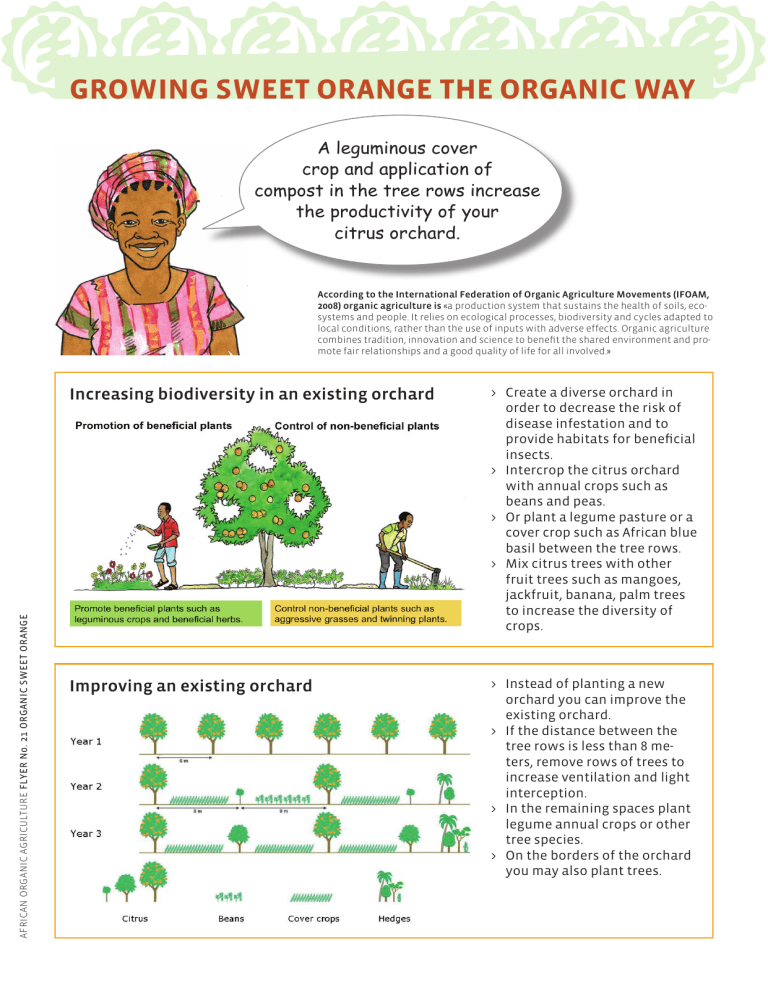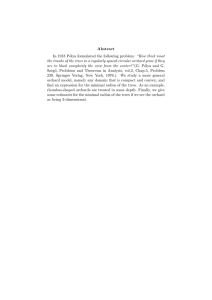
GROWING Sweet Orange THE ORGANIC WAY A leguminous cover crop and application of compost in the tree rows increase the productivity of your citrus orchard. AFRICAN ORGANIC AGRICULTURE FLYER No. 21 ORGANIC SWEET ORANGE According to the International Federation of Organic Agriculture Movements (IFOAM, 2008) organic agriculture is «a production system that sustains the health of soils, ecosystems and people. It relies on ecological processes, biodiversity and cycles adapted to local conditions, rather than the use of inputs with adverse effects. Organic agriculture combines tradition, innovation and science to benefit the shared environment and promote fair relationships and a good quality of life for all involved.» Increasing biodiversity in an existing orchard >> Create a diverse orchard in order to decrease the risk of disease infestation and to provide habitats for beneficial insects. >> Intercrop the citrus orchard with annual crops such as beans and peas. >> Or plant a legume pasture or a cover crop such as African blue basil between the tree rows. >> Mix citrus trees with other fruit trees such as mangoes, jackfruit, banana, palm trees to increase the diversity of crops. Improving an existing orchard >> Instead of planting a new orchard you can improve the existing orchard. >> If the distance between the tree rows is less than 8 meters, remove rows of trees to increase ventilation and light interception. >> In the remaining spaces plant legume annual crops or other tree species. >> On the borders of the orchard you may also plant trees. AFRICAN ORGANIC AGRICULTURE FLYER No. 21 ORGANIC SWEET ORANGE Improving soil fertility >> Prevent loss of topsoil. >> Plant a permanent, locally adapted leguminous soil cover in the tree rows, such as velvet bean and lablab, to supply the trees with nitrogen. >> Apply every year at least 20 kg or 2 buckets of well-rotted cattle manure or compost to each tree. Enhancement of plant health Make best use of preventive measures to ensure healthy trees and avoid heavy infections. Apply the following measures in addition to the ones listed on the left: >> Encourage natural enemies with cover crops, hedges and flower strips. >> Maintain proper field hygiene by regularly removing infested fruits and branches from the orchard. Proper post-harvest handling of fruits >> Handle fruits with care after picking to avoid damages. >> Fruits destined for processing should be processed very quickly after harvest to avoid quality losses. >> Cool storage at 0 to 4 °C allows keeping the fruits for a long period with little loss in quality. Imprint Publisher: FiBL, Research Institute of Organic Agriculture, Switzerland, www.fibl.org; in collaboration with National Organic Agriculture Movements from Africa. First interim draft version, 2011. This and all other materials resulting from the African Organic Agriculture Training Manual project are available free of charge at www.organic-africa.net.
